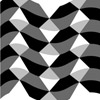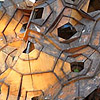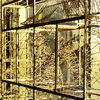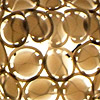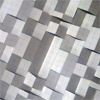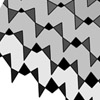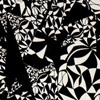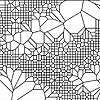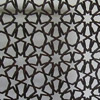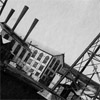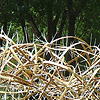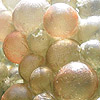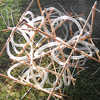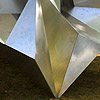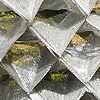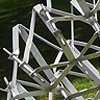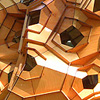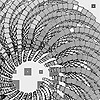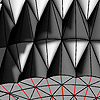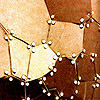Unlike the classical Pattern Deformations assignment discussed here and here, this time we asked Design Geometry students in 2014 to explore deformations by using referential systems as a secondary space. We wanted them to create variations on a regular pattern only by deforming its underpinning lattice. Below are three examples of this alternative assignment. I’m thinking about improving this exercise to three dimensions, seems possible to implement by using the cage […]
Posts categorized under Education
Here are some before and after photos of our first-year Computation-based Basic Design student works. In the beginning, they were all full of life, nevertheless, after a couple of seasons, things started to change slowly. Although they look old and deformed, they are still standing. Reason: Extending the phase space of material performance, unfolding the impossibility of permanence… Or just snow load. It used to be quite durable until recently. Reason: […]
The final countdown has started until the jury of this semester’s Basic Design studio. Everyone is excited to see the products of this year’s architecture, interior design, and industrial design students, while they are trying to set a higher standard for the exercise. They’ll use both digital and physical media to unfold their design intentions about a systematic whole. Below is the current situation of our group together with Fulya […]
This year’s “Lanterns” assignment was nothing short of spectacular. It left both the students and faculty in awe of the creative brilliance displayed. Despite facing constraints in terms of time and experience, the Basic Design students surpassed all expectations. They crafted mesmerizing compositions of polyhedra and intricate unrolled surfaces. Their ability to conceptualize and execute such remarkable lantern designs can be attributed to the valuable skills they honed in their […]
Basic Design I exercise called “Cut and Fold: Deviation” explores diversity within relationships and material behavior. It is initially introduced by Salih Küçüktuna as a simple but effective exercise platform. Below are some students’ works on this one-week exercise. The term “deviation” has many uses in a range of fields from medicine to sociology. However, it is frequently used in statistics with an interesting evocation to design computing: In mathematics […]
Below is some student works from this year’s Architectural Geometry / Pattern Deformations assignment. Students developed their own pattern deformation sequences mostly on regular tessellations. Based on the classical Parquet Deformation exercise, we tried to implement a rule-based approach in order to explore emergent patterns. The exercise seems to reveal endless improvisation potential. The exercise requires students to design a pattern deformation on a 28cm by 28cm area. It should […]
Below are some of the student works from the 4th-week exercise Bits and Pieces of this semester’s Basic Design studio. The gestalt notion of “figure-ground phenomenon” refers to the characteristic organization of perception into a figure that ‘stands out’ against an undifferentiated background. What is figural at any one moment depends on patterns of sensory stimulation. And on the momentary interests of the perceiver. Thus, the figure-ground relationship is an […]
This was the initial example of image processing in our Parametric Modeling class. I saw this design on Maxthreads Architectural Design’s website (especially here). Hand-drawn and digital diagrams can also be digitized and used in order to describe certain parameters for design formation. Such algorithms would similarly use the Image Sampler Component of Grasshopper. In the algorithm below, image data is used to capture black pixels as attractors of a Voronoi subdivision. […]
This was my first parametric patterning study we conducted together with Birgül Çolakoğlu at Yıldız Technical University in 2008. It was based on the pattern exercises we’ve experienced with BOT Graduate Students as a preliminary study within a Computational Design Studio. Later, the CNC fabrications were exhibited at İstanbul Bilgi University Digital Design Symposium. The exercise was about analyzing and reconstructing regular İslamic Patterns via MaxScript. After fundamental instructions about the […]
ARCH 362 COURSE BRIEF (2013) Design computing reflects a focal shift from the singular construction of objects into the relational nature of revealing diversity. Algorithms are mainstream interfaces for the explication of geometric relationships, extending techniques required for such revealing. This course introduces some ways of managing diversity while reasoning about sequential and concurrent; absolute and relational; ordered and chaotic. Students are expected to be familiar with fundamentals of Rhino3D, […]
This is another brave group of students. They studied one of the most interesting materials in this year’s Basic Design studio. They tested the structural capacities and nearly all possibilities of thin Bamboo sticks. Unfortunately, they lost most of the prototypes, and one of them was a beautiful structural tripod. In the final assembly, they managed to span the required distance by attaching bamboo sticks using plastic fasteners. Below are […]
The material system experienced here is an extreme example of our final projects in İstanbul Bilgi University Faculty of Architecture, first-year Basic Design studio. Students studied fiberglass as their core material and they searched for weeks to find a proper way to expose this material’s potential into a spanning structure. They tried lots of different components, basically using molds to give shape to glass fibers. However, their final decision was […]
Here is the “hose” group of the İstanbul Bilgi University Faculty of Architecture Basic Design project. Although they were challenged with a nearly impossible mission, trying to make a structural system out of hoses, they simply did it well. After a tremendous effort on the possible combinations of hoses and wooden sticks, they found sophisticated components, utilizing the positive potentials of both materials. This year, we allowed them to develop […]
Below is one of the fourteen final projects of the freshman year Basic Design studio in İstanbul Bilgi University Faculty of Architecture. The component is made of folded aluminum sheets. Students insist that this is the most optimal solution to the problem of polyhedra in a component-based structure. They experimented with this shape a lot and tried their best to make one that has similar triangular faces on different sides, […]
This group used aluminum expanded mesh in order to test its balance between structural capacity and weight. They folded different-sized sheets to create components, then assembled them creating a span of 2,5 meters approx. They managed to control the macro form by manipulating the component precisely. This year, the dominant discussion among the studio instructors was the context; how to include (or not include), manage, and think about the context, […]
The material system of group 2 at İBU Basic Design project was based on a component developed using tensegrity forces on aluminum bands. Although it was hard to maintain structural solidity with the heavy material, they proved that letting aluminum fly over a predefined distance (at least for a limited time) is possible. *Students: Büşra Kavuk, Büşra Pamuk, Mustafa Sert, Ahmet Evci, Safa Bayam, Sibel Küçükcoşkun, Gizem Işıkalp, Serenay Erbektaş, […]
The following posts will include some of the final projects, completed in Basic Design Studio, İstanbul Bilgi University Faculty of Architecture in 2013. Below, you see the amazing work of group 1, an interlocking system that presents diversity and structural integrity at the same time. This project initiated a hard discussion among the final jury. I think the interesting geometric underlying, great precision for a hand-made computer modeling of each […]
A newly established student club, “E3 Architecture and Design” is organizing a two-day workshop at İstanbul Bilgi University Faculty of Architecture between June 10-11, 2013. The Grasshopper Workshop will be the first one in the faculty. The event will be conducted at our computer lab. so the seats are limited to 28. I’ll try to explain the basic concepts of dataflow management in computer-aided design. Also, I plan to test […]
In Design Computing class, we have discussed how the parametric wall study (here) can be implemented to describe regular curved surfaces such as domes. This led us to well-known design compositions named Muqarnas. Previously we have studied how a parametric muqarnas definition could be in Grasshopper (here). After a couple of weeks of study, students started to capture the idea of generating seamless surfaces out of a few components. Of […]
The “Re_Flex Patterning” workshop will be conducted at İzzet Baysal University Faculty of Engineering and Architecture between 6-8th May 2013. The workshop is led by Tuğrul Yazar and Fulya Akipek, from the İstanbul Bilgi University Faculty of Architecture. Integrating digital media with the material world reveals emergent performances. Parametric modeling techniques encourage designers to study more on the envelopes of potentials instead of singular artifacts. Working with these envelopes tells […]

